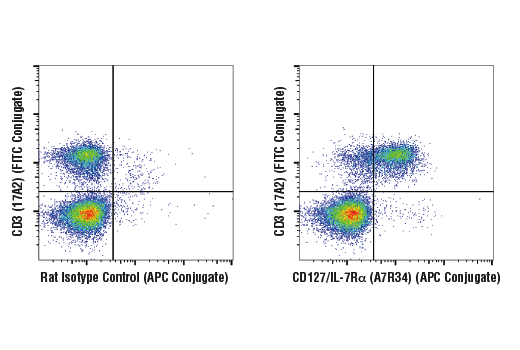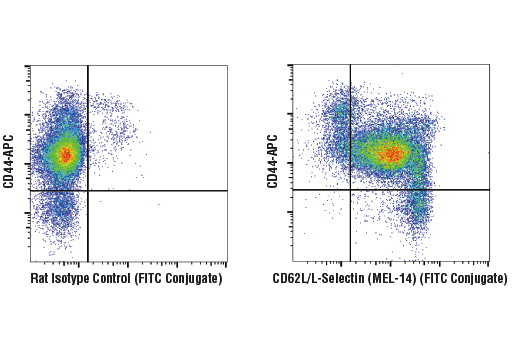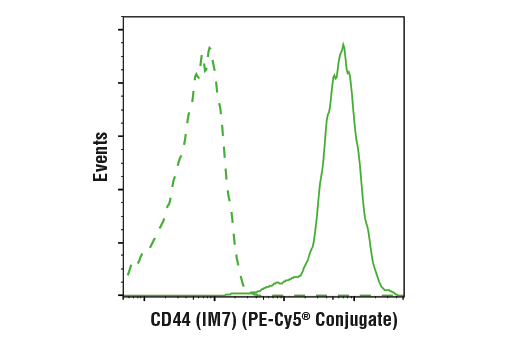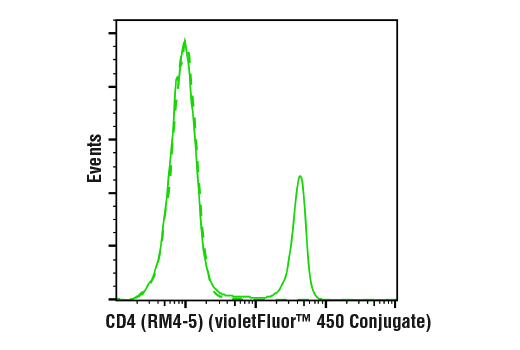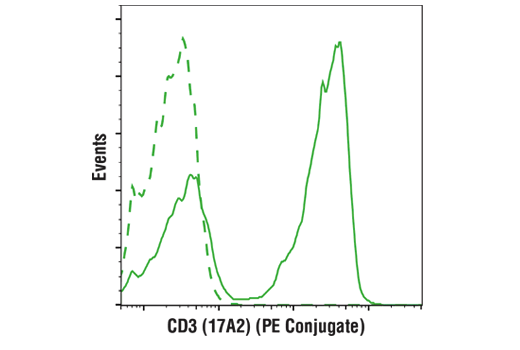FC-L
#P16872, #P06332, #P18337, #P22646, #P16070, #P11942, #P01731
16197, 12504, 20343, 12501, 960, 12502, 12525
Product Information
Product Usage Information
Gating strategy for observing naive, effector, and memory T cell subsets:
If Propidium Iodide or 7-AAD was used, first gate on viable cells. Next, gate on lymphocytes based on forward scatter and side scatter. Helper T cells are the CD3+CD4+ cells within the lymphocyte gate. Cytotoxic T cells are the CD3+CD8+ cells within the lymphocyte gate. Next, observe expression of CD44 vs. CD62L on either helper T cells or cytotoxic T cells. Naive T cells are CD44-CD62L+. Central memory T cells are CD44+CD62L+. Effector memory and effector cells are CD44+CD62L-. To distinguish effector memory and effector cells, observe expression of CD127/IL-7Rα on the CD44+CD62L- population. Effector memory cells are positive for expression of CD127/IL-7Rα. Effector cells are negative for expression of CD127/IL-7Rα. Naive and central memory T cells also express CD127/IL-7Rα.
Storage
All components in this kit are stable in accordance with the date printed on the outer packaging label when stored at the recommended temperature. Please refer to product labels, datasheets, or web pages for specific “Best By” dates for each individual component.
Specificity / Sensitivity
Species Reactivity:
Mouse
Source / Purification
Monoclonal antibodies were purified from tissue culture supernatant via affinity chromatography. The purified antibodies were conjugated under optimal conditions, with unreacted dye removed from the preparation.
Product Description
T cells are identified by expression of CD3. There are two major subsets of conventional T cells: helper T cells which express CD4, and cytotoxic T cells which express CD8. Naive, effector, effector memory, and central memory T cell states can be distinguished by differential expression patterns of CD44, CD62L, and CD127/IL-7Rα.
Species Reactivity
Species reactivity is determined by testing in at least one approved application (e.g., western blot).
Applications Key
FC-L: Flow Cytometry (Live)
Cross-Reactivity Key
H: human M: mouse R: rat Hm: hamster Mk: monkey Vir: virus Mi: mink C: chicken Dm: D. melanogaster X: Xenopus Z: zebrafish B: bovine Dg: dog Pg: pig Sc: S. cerevisiae Ce: C. elegans Hr: horse GP: Guinea Pig Rab: rabbit All: all species expected
Trademarks and Patents
Limited Uses
Except as otherwise expressly agreed in a writing signed by a legally authorized representative of CST, the following terms apply to Products provided by CST, its affiliates or its distributors. Any Customer's terms and conditions that are in addition to, or different from, those contained herein, unless separately accepted in writing by a legally authorized representative of CST, are rejected and are of no force or effect.
Products are labeled with For Research Use Only or a similar labeling statement and have not been approved, cleared, or licensed by the FDA or other regulatory foreign or domestic entity, for any purpose. Customer shall not use any Product for any diagnostic or therapeutic purpose, or otherwise in any manner that conflicts with its labeling statement. Products sold or licensed by CST are provided for Customer as the end-user and solely for research and development uses. Any use of Product for diagnostic, prophylactic or therapeutic purposes, or any purchase of Product for resale (alone or as a component) or other commercial purpose, requires a separate license from CST. Customer shall (a) not sell, license, loan, donate or otherwise transfer or make available any Product to any third party, whether alone or in combination with other materials, or use the Products to manufacture any commercial products, (b) not copy, modify, reverse engineer, decompile, disassemble or otherwise attempt to discover the underlying structure or technology of the Products, or use the Products for the purpose of developing any products or services that would compete with CST products or services, (c) not alter or remove from the Products any trademarks, trade names, logos, patent or copyright notices or markings, (d) use the Products solely in accordance with CST Product Terms of Sale and any applicable documentation, and (e) comply with any license, terms of service or similar agreement with respect to any third party products or services used by Customer in connection with the Products.
